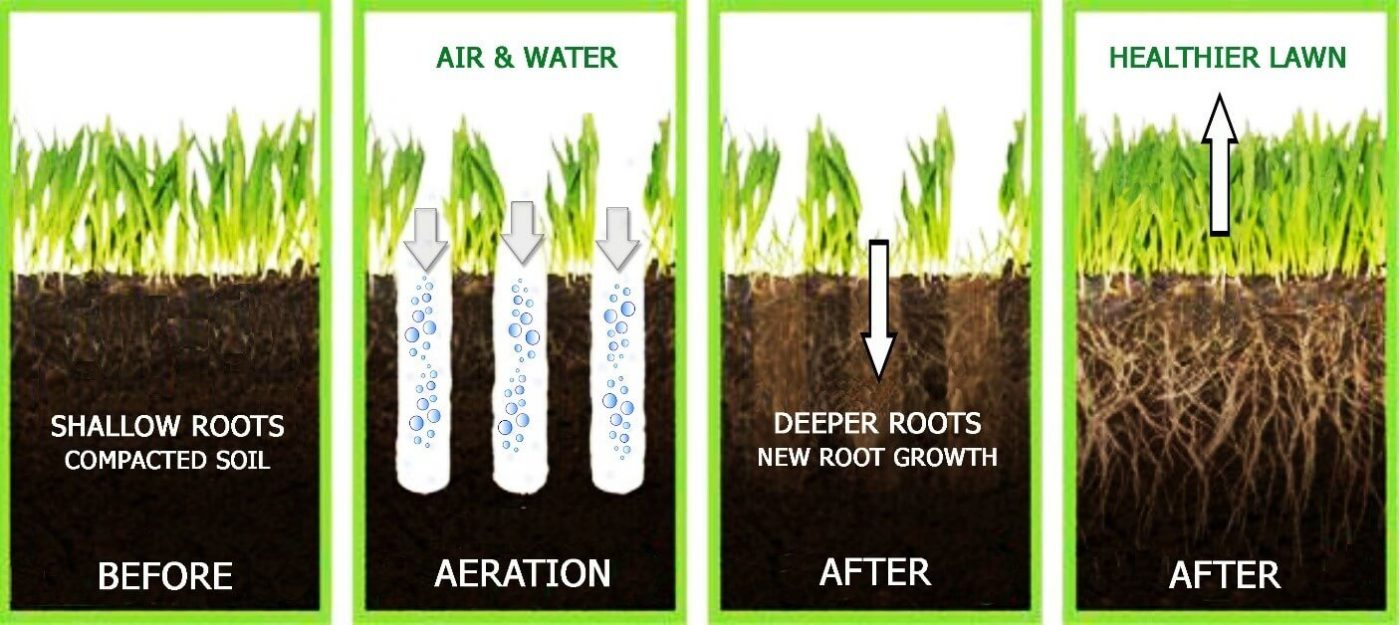
Understanding Aeration
Imagine your lawn as a bustling city, with each blade of grass representing a busy resident. Just like any thriving metropolis, your lawn needs a steady flow of essential resources – water, air, and nutrients – to keep its inhabitants healthy and happy. But over time, the relentless march of foot traffic, mowing, and environmental factors can compact the soil, choking off that vital supply line.
Enter aeration, the process of punching small holes throughout your lawn. It’s like opening up a series of underground highways, allowing those precious resources to reach the roots where they’re needed most. By breaking up the compacted soil, aeration encourages deeper root growth, improved drainage, and better nutrient absorption – all the ingredients for a lush, vibrant lawn.
The Benefits of Aeration
-
- Reduced Soil Compaction: As the soil becomes more dense and packed down, it becomes increasingly difficult for grass roots to penetrate and access the water, air, and nutrients they need to thrive. Aeration alleviates this issue by creating channels for these essential elements to reach the root zone.
- Enhanced Water and Nutrient Absorption: With the soil loosened and aerated, water and fertilizers can more easily penetrate the ground and be absorbed by the grass roots. This helps ensure your lawn is getting the nourishment it requires to stay healthy and green.
- Improved Thatch Breakdown: Thatch, the layer of dead and living grass stems and roots that can accumulate on the soil surface, can prevent proper water and air circulation. Aeration helps speed up the decomposition of thatch, keeping your lawn breathing easy.
- Stronger Root Development: By opening up the soil, aeration encourages grass roots to grow deeper and more extensive, making your lawn more resilient to drought, pests, and other environmental stresses.
- Reduced Weed Invasion: As your grass becomes healthier and more vigorous, it’s better equipped to outcompete opportunistic weeds, keeping your lawn looking clean and uniform.
Timing is Everything
When it comes to aeration, timing is crucial. The best time to aerate your lawn will depend on the type of grass you have, as well as your local climate. For cool-season grasses like fescue and Kentucky bluegrass, the optimal window is typically in the early spring or fall, when the grass is actively growing. Warm-season varieties like Bermuda and Zoysia fare best with late spring or early summer aeration.
Regardless of your grass type, the key is to aerate when the soil is moist but not waterlogged. Aim for a day or two after a good rainfall or thorough irrigation session. This ensures the soil is pliable enough for the aerator to effectively punch those all-important holes.
The Power of Overseeding
While aeration lays the groundwork for a healthier lawn, overseeding takes the transformation to the next level. Overseeding involves spreading a fresh layer of grass seed over your existing turf, filling in bare spots and thickening the overall coverage.
Think of it as a lawn makeover – aeration creates the perfect canvas, while overseeding adds the vibrant, lush new growth that takes your outdoor space to new heights. By introducing new grass varieties tailored to your climate and soil conditions, overseeding can help improve your lawn’s resilience against weeds, pests, and environmental stresses.
The Benefits of Overseeding
-
- Filling in Bare Spots: Over time, even the most well-maintained lawns can develop thin or bare patches, often due to heavy foot traffic, drought, or disease. Overseeding allows you to fill in these problem areas, creating a uniform, healthy appearance.
- Increased Density and Thickness: By adding a fresh layer of grass seed, overseeding helps thicken your existing turf, resulting in a lush, carpet-like appearance that’s more resistant to weed invasion.
- Improved Drought and Pest Resistance: Different grass varieties have varying levels of tolerance to environmental stressors. Overseeding with a diverse seed blend can help your lawn better withstand drought, pests, and disease.
- Rejuvenation of Aging Lawns: As grass plants reach the end of their lifespan, overseeding can introduce new, vibrant growth to revitalize your outdoor space, keeping it looking its best.
- Enhanced Aesthetic Appeal: A thick, lush lawn is the foundation for a beautifully landscaped outdoor area. Overseeding can transform a tired, patchy turf into a verdant, eye-catching centerpiece.
Timing and Technique
Just like aeration, the optimal time to overseed your lawn is determined by the type of grass you have and your local climate. For cool-season grasses, the fall season is ideal, as the cooler temperatures and increased moisture promote rapid germination and establishment of the new seedlings.
Warm-season varieties, on the other hand, thrive when overseeded in late spring or early summer, when the soil is warm and conditions are favorable for growth.
When it comes to the overseeding process itself, start by mowing your lawn short, then use a dethatching or vertical mowing tool to expose the soil. This allows the new seeds to make direct contact with the ground, enhancing their chances of successful germination.
Next, spread the seed evenly across the lawn, either by hand or with a broadcast spreader. Be sure to follow the recommended seeding rate for your specific grass type and climate. Finally, lightly rake the seed into the soil, then water thoroughly and consistently until the new grass has become established.
The Dynamic Duo: Aeration and Overseeding
While aeration and overseeding can be effective on their own, the real magic happens when you combine these two lawn-reviving techniques. By first loosening the soil with aeration, you create the perfect environment for the new grass seed to take root and thrive.
The aeration process opens up channels for water, air, and nutrients to reach the root zone, while the overseeding introduces a fresh crop of resilient, climate-adapted grass plants. Together, these complementary practices work in harmony to transform a tired, patchy lawn into a lush, healthy oasis.
Preparing for the Dynamic Duo
Before embarking on your aeration and overseeding journey, there are a few important steps to take to ensure the best possible results:
-
- Mow Low: A few days before aeration, mow your lawn as short as possible without damaging the grass. This helps expose the soil and allows the aerator to penetrate more effectively.
- Irrigation Inspection: Walk your lawn and inspect your irrigation system, if you have one. Check for any clogged or malfunctioning sprinkler heads, and make necessary repairs to ensure even water coverage.
- Debris Removal: Thoroughly rake or blow away any accumulated leaves, sticks, or other debris that could interfere with the aeration and overseeding process.
- Soil Testing: Consider having your soil tested to determine its pH and nutrient levels. This information can help you select the right grass seed and make any necessary soil amendments before overseeding.
- Timing Considerations: As mentioned earlier, time your aeration and overseeding to coincide with the optimal growth periods for your particular grass type and climate.
The Dynamic Duo in Action
Once you’ve completed the preparatory steps, it’s time to put the dynamic duo to work. Start by aerating your lawn, using a core aerator to punch those all-important holes throughout the turf. Be sure to make multiple passes in different directions to ensure even coverage.
Next, spread your chosen grass seed over the aerated lawn, either by hand or with a broadcast spreader. Aim for the recommended seeding rate, and consider mixing in a starter fertilizer to give the new seedlings a nutrient-rich boost.
Finally, lightly rake the seed into the soil, ensuring good seed-to-soil contact. Water the area thoroughly, and continue to keep the soil consistently moist until the new grass has become established – typically 2-4 weeks for cool-season grasses and 1-2 weeks for warm-season varieties.
Maximizing Your Investment
Aeration and overseeding are powerful tools, but to truly get the most out of your lawn-reviving efforts, it’s important to consider a few additional steps that can help take your outdoor space to the next level.
Topdressing for Optimal Results
While aeration and overseeding address issues like compaction and bare spots, they don’t necessarily solve problems related to poor soil quality. That’s where topdressing comes into play.
Topdressing involves spreading a thin layer of compost, topsoil, or other soil amendment over your lawn after aeration and overseeding. This not only helps fill in any remaining bare patches but also improves the overall nutrient content and water-holding capacity of your soil.
By incorporating topdressing into your lawn care regimen, you’re giving your grass the best possible foundation to thrive, ensuring that the new seedlings and revitalized root systems have access to the essential nutrients they need.
Ongoing Maintenance and Care
Of course, aeration and overseeding aren’t one-and-done solutions. To maintain the vibrant, healthy lawn you’ve worked so hard to create, it’s important to continue with regular maintenance and care.
This includes:
-
- Mowing at the optimal height for your grass type
- Consistent, deep watering to encourage deep root growth
- Timely application of appropriate fertilizers and soil amendments
- Vigilant weed control to prevent unwanted invaders
- Periodic re-aeration and overseeding, typically every 2-3 years
By staying on top of these essential lawn care tasks, you’ll ensure that your aeration and overseeding efforts continue to pay dividends, keeping your outdoor space looking its absolute best year after year.
A&A Provides Aeration and Overseeding Services
Aeration
Too much thatch can choke your lawn. For many years, professional golf course greens keepers have known that the secret to a beautiful, dense turf is aeration. By aerating their courses two to three times each year the grass roots grow more healthy and the plants thrive!
> Learn More About AerationOverseeding
The lawn you choose should be sown, fed and re-seeded according to its type. For cool season favorites like perennial rye, Kentucky bluegrass and the fescues, the time to sow seed—whether to fill in bare spots or plant a brand new lawn—is in the “Fall”, actually mid-August to mid-September.
> Learn More About Overseeding
Aeration and overseeding may sound like industry jargon. but we can attest to its transformative power. By loosening compacted soil and introducing a fresh crop of resilient grass, these dynamic duo techniques can breathe new life into even the most tired and neglected lawns.
Contact Us (859-384-0266) for a Free Consultation!
Get an Instant Quote
—
 About A & A Lawn Care & Landscaping
About A & A Lawn Care & Landscaping
A & A Lawn Care & Landscaping can beautify your lawn and landscaping using our vast experience in turf grass management. Our complete lawn service is designed for both residential and commercial lawns and we keep your lawn healthy without harming your family, staff, or pets.

